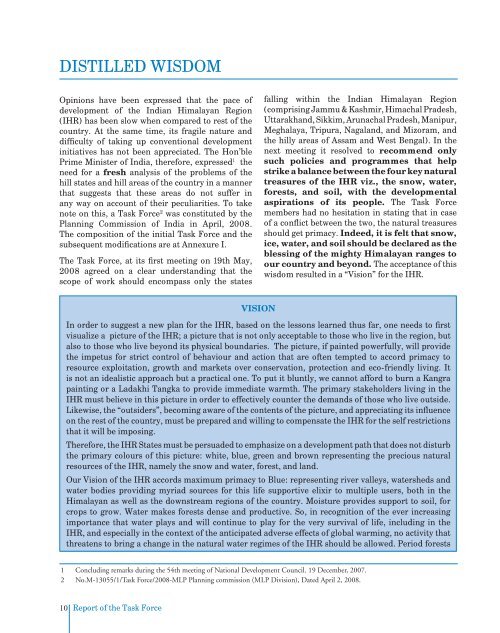Task Force Report - Govind Ballabh Pant Institute of Himalayan ...
Task Force Report - Govind Ballabh Pant Institute of Himalayan ...
Task Force Report - Govind Ballabh Pant Institute of Himalayan ...
You also want an ePaper? Increase the reach of your titles
YUMPU automatically turns print PDFs into web optimized ePapers that Google loves.
DISTILLED WISDOM<br />
Opinions have been expressed that the pace <strong>of</strong><br />
development <strong>of</strong> the Indian <strong>Himalayan</strong> Region<br />
(IHR) has been slow when compared to rest <strong>of</strong> the<br />
country. At the same time, its fragile nature and<br />
difficulty <strong>of</strong> taking up conventional development<br />
initiatives has not been appreciated. The Hon’ble<br />
Prime Minister <strong>of</strong> India, therefore, expressed 1 the<br />
need for a fresh analysis <strong>of</strong> the problems <strong>of</strong> the<br />
hill states and hill areas <strong>of</strong> the country in a manner<br />
that suggests that these areas do not suffer in<br />
any way on account <strong>of</strong> their peculiarities. To take<br />
note on this, a <strong>Task</strong> <strong>Force</strong> 2 was constituted by the<br />
Planning Commission <strong>of</strong> India in April, 2008.<br />
The composition <strong>of</strong> the initial <strong>Task</strong> <strong>Force</strong> and the<br />
subsequent modifications are at Annexure I.<br />
The <strong>Task</strong> <strong>Force</strong>, at its first meeting on 19th May,<br />
2008 agreed on a clear understanding that the<br />
scope <strong>of</strong> work should encompass only the states<br />
falling within the Indian <strong>Himalayan</strong> Region<br />
(comprising Jammu & Kashmir, Himachal Pradesh,<br />
Uttarakhand, Sikkim, Arunachal Pradesh, Manipur,<br />
Meghalaya, Tripura, Nagaland, and Mizoram, and<br />
the hilly areas <strong>of</strong> Assam and West Bengal). In the<br />
next meeting it resolved to recommend only<br />
such policies and programmes that help<br />
strike a balance between the four key natural<br />
treasures <strong>of</strong> the IHR viz., the snow, water,<br />
forests, and soil, with the developmental<br />
aspirations <strong>of</strong> its people. The <strong>Task</strong> <strong>Force</strong><br />
members had no hesitation in stating that in case<br />
<strong>of</strong> a conflict between the two, the natural treasures<br />
should get primacy. Indeed, it is felt that snow,<br />
ice, water, and soil should be declared as the<br />
blessing <strong>of</strong> the mighty <strong>Himalayan</strong> ranges to<br />
our country and beyond. The acceptance <strong>of</strong> this<br />
wisdom resulted in a “Vision” for the IHR.<br />
VISION<br />
In order to suggest a new plan for the IHR, based on the lessons learned thus far, one needs to first<br />
visualize a picture <strong>of</strong> the IHR; a picture that is not only acceptable to those who live in the region, but<br />
also to those who live beyond its physical boundaries. The picture, if painted powerfully, will provide<br />
the impetus for strict control <strong>of</strong> behaviour and action that are <strong>of</strong>ten tempted to accord primacy to<br />
resource exploitation, growth and markets over conservation, protection and eco-friendly living. It<br />
is not an idealistic approach but a practical one. To put it bluntly, we cannot afford to burn a Kangra<br />
painting or a Ladakhi Tangka to provide immediate warmth. The primary stakeholders living in the<br />
IHR must believe in this picture in order to effectively counter the demands <strong>of</strong> those who live outside.<br />
Likewise, the “outsiders”, becoming aware <strong>of</strong> the contents <strong>of</strong> the picture, and appreciating its influence<br />
on the rest <strong>of</strong> the country, must be prepared and willing to compensate the IHR for the self restrictions<br />
that it will be imposing.<br />
Therefore, the IHR States must be persuaded to emphasize on a development path that does not disturb<br />
the primary colours <strong>of</strong> this picture: white, blue, green and brown representing the precious natural<br />
resources <strong>of</strong> the IHR, namely the snow and water, forest, and land.<br />
Our Vision <strong>of</strong> the IHR accords maximum primacy to Blue: representing river valleys, watersheds and<br />
water bodies providing myriad sources for this life supportive elixir to multiple users, both in the<br />
<strong>Himalayan</strong> as well as the downstream regions <strong>of</strong> the country. Moisture provides support to soil, for<br />
crops to grow. Water makes forests dense and productive. So, in recognition <strong>of</strong> the ever increasing<br />
importance that water plays and will continue to play for the very survival <strong>of</strong> life, including in the<br />
IHR, and especially in the context <strong>of</strong> the anticipated adverse effects <strong>of</strong> global warming, no activity that<br />
threatens to bring a change in the natural water regimes <strong>of</strong> the IHR should be allowed. Period forests<br />
1 Concluding remarks during the 54th meeting <strong>of</strong> National Development Council. 19 December, 2007.<br />
2 No.M-13055/1/<strong>Task</strong> <strong>Force</strong>/2008-MLP Planning commission (MLP Division), Dated April 2, 2008.<br />
10<br />
<strong>Report</strong> <strong>of</strong> the <strong>Task</strong> <strong>Force</strong>

















